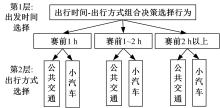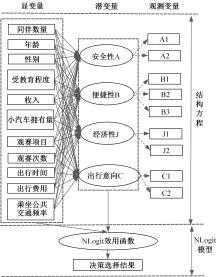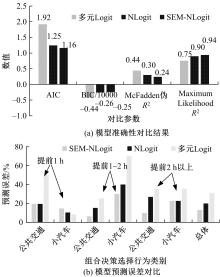Journal of Jilin University(Engineering and Technology Edition) ›› 2024, Vol. 54 ›› Issue (4): 979-986.doi: 10.13229/j.cnki.jdxbgxb.20220675
Previous Articles Next Articles
Combined decision-choice behavior of spectators considering personal preferences
Zhi-hua XIONG1( ),Dai-yue DONG2,Chun-jiao DONG1(
),Dai-yue DONG2,Chun-jiao DONG1( ),Yan ZHENG3,Chao XIE4
),Yan ZHENG3,Chao XIE4
- 1.Key Laboratory of Transport Industry of Big Data Application Technologies for Comprehensive Transport,Ministry of Transport,Beijing Jiaotong University,Beijing 100044,China
2.Zhejiang Scientific Research Institute of Transport,Hangzhou 310000,China
3.School of Transportation,Southeast University,Nanjing 211102,China
4.China Transport Information Co. ,Ltd. ,Beijing 100029,China
CLC Number:
- U491.1
| 1 | 谢陶,杨欢. 全球赛事影响力榜单公布:中国登顶榜首 成都首进全球前30城市[EB/OL]. [2009-04-30]. . |
| 2 | 赵丹,邵春福,王军利,等. 多方式诱导下通勤出行链交通方式组合选择行为模型[J]. 吉林大学学报:工学版,2015,45(6):1763-1770. |
| Zhao dan, Shao chun-fu, Wang jun-li, et al. Modelling combined mode choice behavior of commute trip chain under multi-modal guidance[J]. Journal of Jilin University(Engineering and Technology Edition), 2015,45(6):1763-1770. | |
| 3 | 王月,姚恩建,郝赫. 低碳导向的多模式交通出行服务定价策略[J]. 清华大学学报:自然科学版,2023,63(11):1741-1749. |
| Wang Yue, Yao En-jian, Hao He. Low-carbon-oriented pricing strategy of multi-mode transportation service[J]. Journal of Tsinghua University(Science and Technology), 2023, 63(11):1741-1749. | |
| 4 | 于晓桦,刘欣萍,毕亚茹,等. 基于出行效用无差异阈值的组合交通客流分配模型[J]. 交通运输工程与信息学报,2023,21(4):25-34. |
| Yu Xiao-hua, Liu Xin-ping, Bi Ya-ru, et al. Passenger flow distribution model for combined transportation modes based on travel utility indifference threshold[J]. Journal of Transportation Engineering and Information, 2023, 21(4):25-34. | |
| 5 | Jou R. Modeling the impact of pre-trip information on commuter departure time and route choice[J]. Transportation Research Part B: Methodological, 2001, 35(10): 887-902. |
| 6 | Jong G, Daily A, Pieters M, et al. A model for time of day and mode choice using error components logit[J]. Transportation Research Part E: Logistics and Transportation Review, 2003, 39(3): 245-268. |
| 7 | 张波,隽志才,林徐勋. 基于累积前景理论的出发时间选择SDUO模型[J].管理工程学报, 2013,27(1):68-76. |
| Zhang Bo, Zhi-cai Juan, Lin Xu-xun. Stochastic dynamic user optimum model with departure time choice based on cumulative prospect theory[J]. Journal of Industrial Engineering and Engineering Management, 2013,27(1):68-76. | |
| 8 | 诸葛承祥,邵春福,李霞,等.通勤者出行时间与出行方式选择行为研究[J].交通运输系统工程与信息,2012,12(2):126-131. |
| Zhuge Cheng-xiang, Shao Chun-fu, Li Xia, et al. Commuter's choice behavior of travel time and travel mode[J]. Journal of Transportation Systems Engineering and Information Technology, 2012,12(2):126-131. | |
| 9 | Zou M, Li M, Lin X, et al. An agent-based choice model for travel mode and departure time and its case study in Beijing[J]. Transportation Research Part C: Emerging Technologies, 2016(64): 133-147. |
| 10 | 杨励雅,李霞,邵春福.居住地、出行方式与出发时间联合选择的交叉巢式Logit模型[J].同济大学学报:自然科学版, 2012,40(11):1647-1653. |
| Yang Li-ya, Li Xia, Shao Chun-fu. Cross-nested Logit model for joint choice of residential location, travel mode and departure time[J]. Journal of Tongji University(Natural Science), 2012,40(11):1647-1653. | |
| 11 | 杨励雅,李娟.居民出行链、出行方式与出发时间联合选择的交叉巢式Logit模型[J].北京大学学报:自然科学版,2017,53(4):722-730. |
| Yang Li-ya, Li Juan. Cross-nested Logit model for the joint choice of residential location, travel mode and departure time[J]. Acta Scientiarum Naturalium Universitatis Pekinens, 2017,53(4):722-730. |
| [1] | Jiao-rong WU,Qing-kai LIN,Yong-qi DENG. Identification method of potential public transportation lane demand based on bus line operation stability [J]. Journal of Jilin University(Engineering and Technology Edition), 2024, 54(3): 692-699. |
| [2] | Yan ZHUANG,Chun-jiao DONG,Xue-yu MI,Xiao-yu ZHANG,Jing WANG. Travel mode choice in small and media sized city based on random parameters Logit model [J]. Journal of Jilin University(Engineering and Technology Edition), 2024, 54(2): 461-468. |
| [3] | Wen-hui ZHANG,Jing YI. Optimization of bus stop system considering capacity and queuing delays [J]. Journal of Jilin University(Engineering and Technology Edition), 2024, 54(1): 146-154. |
| [4] | Xian-yan KUANG,Zi-ru CHEN. Dynamic game comity behavior at pedestrians′ crossing on unsignal-controlled roads based on cellular automata [J]. Journal of Jilin University(Engineering and Technology Edition), 2022, 52(4): 837-846. |
| [5] | Xing-hua LI,Fei-yu FENG,Cheng CHENG,Wei WANG,Peng-cheng TANG. Choice preference analysis and modeling of ridesplitting service [J]. Journal of Jilin University(Engineering and Technology Edition), 2022, 52(3): 578-584. |
| [6] | Hong-fei JIA,Zi-han SHAO,Li-li YANG. Ride⁃sharing matching model and algorithm of online car⁃hailing under condition of uncertain destination [J]. Journal of Jilin University(Engineering and Technology Edition), 2022, 52(3): 564-571. |
| [7] | Chun-jiao DONG,Dai-yue DONG,Cheng-xiang ZHU-GE,Li ZHEN. Trip characteristics and decision⁃making behaviors modeling of electric bicycles riding [J]. Journal of Jilin University(Engineering and Technology Edition), 2022, 52(11): 2618-2625. |
| [8] | Shi-jun YANG,Yu-long PEI,Heng-yan PAN,Guo-zhu CHENG,Wen-hui ZHANG. Characteristics analysising and prediction of dwelling time of urban bus [J]. Journal of Jilin University(Engineering and Technology Edition), 2021, 51(6): 2031-2039. |
| [9] | Ying-ying MA,Si-yuan LU,Xiao-ming ZHANG,Wen-shu WEI. Model of highway travel selection considering individual risk preference difference [J]. Journal of Jilin University(Engineering and Technology Edition), 2021, 51(5): 1673-1683. |
| [10] | Lei CHEN,Jiang⁃feng WANG,Yuan⁃li GU,Xue⁃dong YAN. Multi⁃source traffic data fusion algorithm based onmind evolutionary algorithm optimization [J]. Journal of Jilin University(Engineering and Technology Edition), 2019, 49(3): 705-713. |
| [11] | HOU Xian-yao, CHEN Xue-wu. Use of public transit information market segmentation based onattitudinal factors [J]. 吉林大学学报(工学版), 2018, 48(1): 98-104. |
| [12] | LI Xia,GAO Li,LIU Yu-guo. Simultaneous residential location and travel mode choice es-timation around rail transit station based on cross-nested logit model [J]. 吉林大学学报(工学版), 2011, 41(6): 1614-1617. |
| [13] | YU De-xin,YANG Zhao-sheng,GAO Peng. Constrained K-shortest paths algorithm within |dynamic restricted searching area [J]. 吉林大学学报(工学版), 2009, 39(增刊2): 172-0176. |
| [14] | YANG Zhao-sheng, YU Yue, YANG Wei. Acquisition of travel time based on inductive coil detector and probe vehicle [J]. 吉林大学学报(工学版), 2009, 39(增刊2): 168-0171. |
| [15] | LI Hua-min,HUANG Hai-jun. Nested Logit model based on a new form of utility function [J]. 吉林大学学报(工学版), 2009, 39(增刊2): 63-0065. |
|
||





